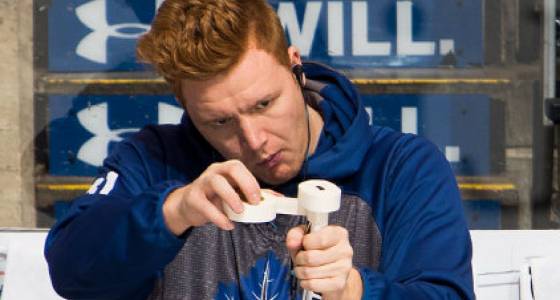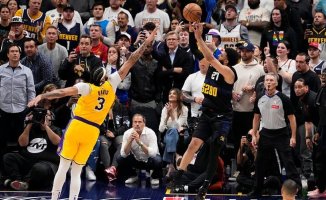It’s become NHL standard procedure. Hockey players, when they’re not surviving the 82-game grind, spend their summers living like monks and training like Olympians.
They pound weights, slurp Gary Roberts-approved protein shakes, feast on organic plates. It’s been like this for years.
And yet it was only in the off-season of 2013 that Maple Leafs goaltender Frederik Andersen found himself at odds with the conventional discipline. At the time still a minor-leaguer in the Anaheim Ducks system, Andersen was fully aware of the sport’s long-held trend toward diligent lifestyles. But he appeared to be of the belief that he might be gifted enough to be the exception to the rule.
So even if he’d been told he was 20-some pounds overweight, and even if he had a reputation for preferring video games and bags of candy to a regimen of off-season betterment — for all those allegedly bad habits, Andersen had just put up the best save percentage among rookie goaltenders in the American Hockey League. He was already an outlier, one of the rare hockey pros to hail from tiny Denmark. Maybe he was also talented enough to skip the gruelling gym regimens embraced by most peers.
“Back then I was literally just playing the game and living off 100 per cent talent. And I thought I was doing fine living off talent,” Andersen was saying in a recent interview in the Maple Leafs dressing room. “I think the best way to put it is, back when you’re a kid, you think that’s a compliment that you’re playing on just talent. It took me a while to learn it’s the opposite.”
That Andersen soon enough grasped this important lesson explains why he finds himself where he does — gutting out what amounts to an ultra-marathon in a goalie mask as the linchpin of the Maple Leafs season. Playing the first season of the five-year, $25-million contract he signed in June, Andersen is on pace to start 67 of Toronto’s 82 games — a mark that would dwarf his previous career high of 53 in 2014-15. With 21 games remaining on Toronto’s schedule, Andersen has already faced more shots as a Leaf than he ever faced in a single season playing behind the vaunted Ducks defence.
With six weeks left in the most crucial stretch of regular-season hockey in recent local memory, the Dane who once shirked off-season work is being counted on as his new team’s essential workhorse.
Maybe none of that would be true if not for Pete Peeters, Andersen’s first pro goaltending coach, who suggested his pupil think ahead to how the retired Frederik Andersen might see his career in hindsight.
“I said to Frederik: If you lose your job because somebody is a better goaltender than you, you will be able to live with that. But if you ever lose your job because you’re out of shape, that’s shame on you,” Peeters, the 1983 Vezina Trophy winner, said over the phone from his farm north of Edmonton.
Andersen says a key impetus to get in shape was provided by Dwayne Roloson, the ex-NHL goaltender who, back in 2013, worked for the Ducks as a goaltending consultant. It was Roloson who insisted Andersen have dinner with Scot Prohaska, the southern California-based strength-and-conditioning coach with whom Roloson trained during a remarkable career that stretched past his 42nd birthday.
Even a few years on, Prohaska still remembers the details of his first encounter with Andersen.
“Freddie’s got his hair long, hat on backwards, flip-flops, dirty shorts,” Prohaska recalled in a recent interview. “Rolly told me (the Ducks) saw Freddie’s potential. But they were questioning his heart. They were questioning his dedication . . . It turned into a three-hour dinner. And the question I asked him was, ‘How do you want your career to be?’ ”
Prohaska, who has trained clients from the NFL, NHL and UFC for years, said he sketched out two possible career arcs for Andersen to ponder.
“I said: Do you want to be a fun guy who (lives a hedonistic lifestyle)? Because that’s fine. That’s just a choice,” Prohaska remembered. “Or do you want to be this guy that people rely on and count on and look up to? I said: Just come in the gym tomorrow and let me know.”
The message seemed to resonate.
“Freddie shows up the next day with a haircut, all Lululemon-ed out, ready to work,” he said. “And I thought, okay, this kid’s serious.’ ”
The ensuing transformation into a leaner, stronger specimen paid off. Over the next three seasons, after becoming strong enough that Prohaska’s NFL clients occasionally suggested the six-foot-four goaltender might have a future as a tight end, Andersen worked his way into Anaheim’s stacked goaltending rotation. Along with playing in a combined 28 playoff games for the Ducks, he won a share of the 2015-16 Jennings Trophy with teammate John Gibson for allowing the fewest goals against. By last spring he was targeted by the Maple Leafs as the crease-minding foundation of a promising rebuilding project.
And Andersen did it all, in Prohaska’s view, by spending his off-seasons becoming less a goaltending specialist and more an all-round athlete.
“Goaltenders can get too specialized, like relief pitchers,” Prohaska said. “Relief pitchers can smoke a cigarette, drink a beer and come out and throw 10 pitches. I don’t want my goalies to be like that. I want them to be athletes.”
Prohaska said the physical challenges, for goalies, are many. Hip and hamstring injuries are common. So, strengthening those areas and working on overall explosiveness have been weight-room priorities for Andersen.
“We’ll do weighted-vest jumping, holding on to a medicine ball and jumping,” Prohaska said.
The training got more intense this past summer, with Andersen well aware that the Maple Leafs would be expecting him to play heavier minutes than he’d ever experienced in Anaheim.
“We anticipated more workload. We anticipated more bruising. We anticipated more pressure,” Prohaska said.
To that end, Andersen said he “mostly” sticks to a diet that includes foods meant to keep inflammation at bay, including staples such as beets, green vegetables and grass-fed beef. Prohaska also suggested a morning ritual that includes deep breathing drills and a sequence of yoga-like moves designed to reset his body and relax his mind.
“He’s a kid who’ll ruminate a little bit on last night’s game … It’s like he’s actually still in the game. His brain is still fight or flight. He’s a deep thinker,” Prohaska said. “I told him: We need to tell your brain that you’re not fight or flight. So, the deep breathing … that tells your brain that you can relax.”
For all the attention to discipline and detail, the season hasn’t been easy. When Andersen was injured in a September Olympic qualifier and missed most of NHL training camp, he slumped through a dismal October for the Leafs. But he turned it around November through January. And after some stumbles in early February, he’s returned to form of late.
“When he was struggling (early in the season) I just said to him: You’re a big-time guy. Figure it out yourself,” said Prohaska. “I think that mindset shift was important. That shift from, ‘I need to call my goalie coach,’ or ‘I need to call my trainer,’ or ‘I need to call my nutritionist,’ because I’m not playing well. Now it’s, ‘Okay. I’m a pro. I need to figure this out myself.’ I think he thinks like that now.”
If Andersen has mostly been left to figure things out for himself, along with Leafs goaltending coach Steve Briere, who is prohibited by team policy from speaking with the media, Andersen said Prohaska and Roloson deserve credit for showing him the path to self-reliance.
“It was a good blessing for Rolly to recommend Scot to me. It really turned my career up a notch and gave me the tools to make it here,” Andersen said. “I realized you want to be known as the guy who works hard and prepares and doesn’t just hang out in the summer instead of working hard. And I guess I found out that if you buy in 100 per cent you’re going to get a good result. The rest, I guess, is history. Here I am.”
The Toronto Star and thestar.com, each property of Toronto Star Newspapers Limited, One Yonge Street, 4th Floor, Toronto, ON, M5E 1E6. You can unsubscribe at any time. Please contact us or see our privacy policy for more information.
Our editors found this article on this site using Google and regenerated it for our readers.












